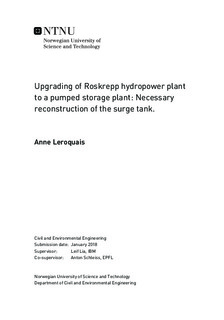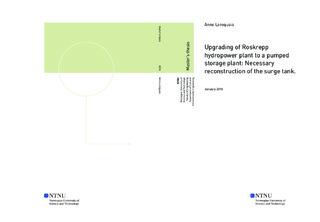| dc.description.abstract | The scope of this thesis is to build a 1D numerical model of a hydraulic powerplant, transform it to simulate the upgrade of the powerplant into a pumped storage system, establish the issues that would emerge from it in the surge tanks and test several solutions to solve them.
The 1D numerical software LVTrans is used to calculate the hydraulic transient in the whole system and simulate the water table movements inside the surge tanks. It uses the Method Of Characteristics to solve the differential equations describing the transient flows.
The transformation of the Roskrepp powerplant, located in the south of Norway, into a pumped storage powerplant is used as a case study. The powerplant includes two separate surge tanks. The main one is a variable surge tank located between the upstream reservoir and the turbine. The second one is smaller and placed near the exit of the turbine, in the downstream part.
The model is build based on the drawings of the powerplant and a calibration is carried out by using data gathered during a field trip.
The upgrade of the model consider the implementation of a 50 MW pump in parallel with the turbine. The results show that the surge tank is sufficient to absorb the mass oscillations taking place in the upstream part of the system. The downstream surge tank is however unable to keep the water table within its boundaries and should be upgraded.
Three solutions are proposed to upgrade the downstream surge tank. The first is to expand the section of the existing surge tank. The second is to transform the surge tank into a variable surge tank by adding an upper and a lower chamber. The third is to implement a throttle at the bottom of the surge tank.
The solutions are tested by implementing them in the LVTrans model and the results show that they are successful in increasing the surge tank capacity to absorb the mass oscillations. An optimal design is proposed for each of them.
Finally, an economic analysis is performed to estimate the costs associated with their implementation. | |

